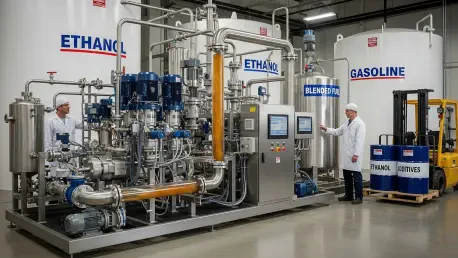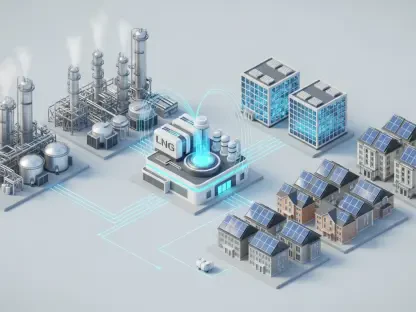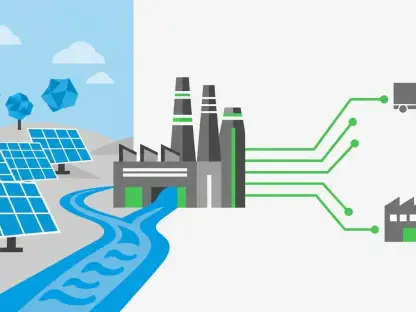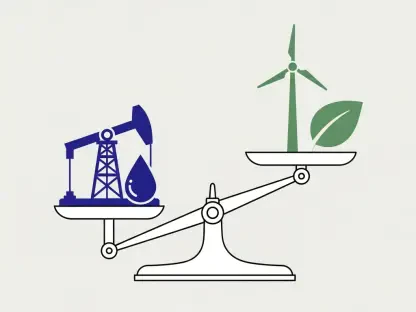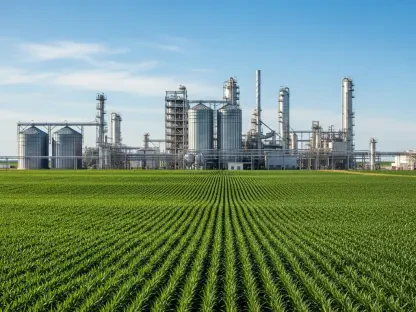Imagine a future where India’s roads hum with vehicles powered by a fuel that slashes greenhouse gas emissions by over 60%, cuts reliance on imported oil, and boosts rural economies—all while maintaining engine performance. This isn’t a distant dream but a reality unfolding through the adoption of 20% ethanol blending (E20) in gasoline. As a pivotal component of India’s energy strategy, E20 technology stands at the intersection of environmental sustainability and energy security. This review delves into the intricacies of ethanol blending, examining its technical merits, real-world impacts, and the challenges it faces in transforming the automotive fuel landscape.
Understanding Ethanol Blending and Its Strategic Importance
Ethanol blending, particularly the integration of 20% ethanol with gasoline to create E20, represents a significant shift in India’s approach to fuel consumption. This technology mixes bioethanol, derived from agricultural sources like sugarcane and corn, with conventional gasoline to produce a cleaner, renewable fuel alternative. Under the guidance of the Ministry of Petroleum and Natural Gas, this initiative aligns with national policies aimed at reducing carbon footprints and fostering energy independence.
The significance of E20 extends beyond mere fuel composition. It serves as a cornerstone of India’s commitment to global sustainability goals, targeting a substantial reduction in fossil fuel dependency. By promoting domestically sourced ethanol, the policy not only addresses environmental concerns but also supports agricultural communities, creating a ripple effect of economic benefits across rural regions.
Technical Deep Dive into E20 Performance and Features
Engine Compatibility and Operational Safety
Extensive research by the Automotive Research Association of India and other institutions has validated E20’s compatibility with a wide range of vehicles. Testing over 100,000 kilometers demonstrated no adverse effects on engine performance, power output, or torque, ensuring that both modern and older models can operate seamlessly. Durability concerns have been largely dispelled through these rigorous evaluations, affirming the technology’s reliability.
Further bolstering confidence, E20 has successfully passed hot and cold startability tests across diverse climatic conditions. Whether in carbureted or fuel-injected systems, no evidence of engine damage or abnormal wear has surfaced. Such findings underscore the meticulous engineering behind this fuel blend, ensuring it meets the practical demands of everyday driving without compromising safety.
Fuel Efficiency Dynamics and Optimization Strategies
One acknowledged aspect of E20 is a slight reduction in fuel efficiency due to ethanol’s lower energy density compared to pure gasoline. For vehicles specifically calibrated for E20, the mileage drop is minimal at 1-2%, while non-calibrated four-wheelers may experience a 3-6% decrease. Though noticeable, this trade-off is marginal when weighed against the broader benefits of the technology.
To counteract this efficiency gap, automakers have embraced advanced engine tuning and adopted E20-compatible materials since early 2023, as supported by the Society of Indian Automobile Manufacturers. These adaptations optimize combustion processes and minimize energy loss, paving the way for smoother integration of E20 into mainstream use. Such innovations highlight the industry’s commitment to aligning with evolving fuel standards.
Material Durability and Maintenance Considerations
Safety standards for E20 incorporate corrosion inhibitors and compatible materials to prevent component degradation, addressing concerns about long-term durability. These measures ensure that fuel systems remain robust even under prolonged exposure to ethanol’s chemical properties. Industry benchmarks have guided the development of these safeguards, maintaining high reliability across vehicle types.
For older vehicles, minor maintenance needs may arise, such as replacing rubber parts or gaskets after 20,000-30,000 kilometers. However, these replacements are cost-effective and can be seamlessly integrated into routine servicing schedules. This manageable upkeep dispels fears of significant financial burdens, making E20 a viable option even for legacy models on the road.
Policy Framework and Implementation Milestones
The rollout of E20 follows a structured plan outlined in the “Roadmap for Ethanol Blending in India 2020-25,” crafted through extensive consultations with vehicle manufacturers and fuel retailers. This strategic blueprint ensures a phased integration, allowing stakeholders to adapt without facing abrupt disruptions. The coordinated approach reflects a balance between ambition and practicality in policy execution.
Such deliberate implementation has facilitated widespread adoption across gasoline supplies, catering to a diverse array of vehicle types. By prioritizing collaboration, the policy framework mitigates potential resistance and fosters a unified transition toward sustainable fuel practices. This methodical progression continues to shape the technology’s acceptance in the market.
Real-World Impact and Environmental Benefits
In practical application, E20 has demonstrated tangible benefits across India’s automotive sector, seamlessly blending into existing fuel distribution networks. Its integration supports a variety of vehicles, from compact cars to heavy-duty models, ensuring broad accessibility. This adaptability underscores E20’s role as a scalable solution for national fuel demands.
Environmentally, the impact is profound, with studies from Niti Aayog indicating that sugarcane-based ethanol reduces greenhouse gas emissions by 65%, and corn-based ethanol by 50%, compared to traditional gasoline. These reductions contribute significantly to India’s climate targets, offering a cleaner alternative without sacrificing performance. Additionally, ethanol’s high octane rating of approximately 108.5 enhances fuel blends to 95 RON, improving efficiency in modern high-compression engines.
Beyond ecological gains, E20 bolsters energy security by cutting reliance on imported crude oil, with savings in foreign exchange exceeding substantial figures over recent years. Payments to farmers for ethanol production have injected vital income into rural economies, fostering job creation and agricultural growth. These multifaceted advantages position E20 as a catalyst for both environmental and economic progress.
Challenges in Adoption and Public Perception
Despite its merits, E20 faces hurdles such as minor mileage reductions, which, though small, can influence consumer sentiment. Older vehicles requiring part replacements also pose a challenge, albeit one easily addressed through routine maintenance. These trade-offs, while manageable, necessitate clear communication to ensure user acceptance.
Public misconceptions, often fueled by media reports of potential vehicle damage, remain a barrier. The Ministry has countered such narratives with scientific evidence, emphasizing the technology’s safety and reliability. Ongoing efforts to enhance consumer awareness aim to dispel myths and build trust in E20 as a dependable fuel choice.
Addressing compatibility across all vehicle models remains a work in progress. While significant strides have been made, ensuring universal readiness requires continued collaboration between policymakers, manufacturers, and service providers. Tackling these issues head-on is crucial for sustaining momentum in E20’s adoption trajectory.
Prospects for Ethanol Blending Expansion
Looking ahead, the potential for ethanol blending to exceed the current 20% threshold holds promise for even greater sustainability gains. Aligning with India’s long-term energy independence goals, higher blends could further reduce fossil fuel reliance. This vision hinges on sustained policy support and investment in biofuel infrastructure.
Technological advancements in engine design and fuel formulations are expected to optimize E20 performance, minimizing existing drawbacks like mileage drops. Innovations in material science may also enhance compatibility, reducing maintenance needs for older vehicles. These developments signal a future where ethanol blending becomes even more efficient and user-friendly.
The broader societal impact includes continued empowerment of rural economies through ethanol production, alongside deeper cuts in carbon emissions. As India moves toward these ambitious targets, ethanol blending stands poised to play a central role in shaping a greener, more self-reliant energy landscape. This trajectory reflects a commitment to balancing progress with pragmatism.
Final Reflections and Path Forward
Reflecting on the journey of E20 technology, extensive research has confirmed its safety and compatibility, with no significant impact on vehicle performance or durability, even in older models. The slight mileage reductions observed are negligible and have been effectively mitigated through technological adjustments by manufacturers. Environmentally, the substantial emission cuts achieved have marked a victory for sustainability, while economically, the support for farmers and foreign exchange savings have proven transformative.
Looking back, the phased policy rollout has successfully debunked concerns of hasty implementation, grounding the initiative in careful planning and stakeholder engagement. Moving forward, the focus should shift to accelerating consumer education campaigns to counter lingering misconceptions, while incentivizing automakers to prioritize E20-ready designs in all new models. Additionally, expanding ethanol production capacity through targeted agricultural programs could ensure supply meets growing demand, solidifying this technology as a bedrock of India’s sustainable energy future.
